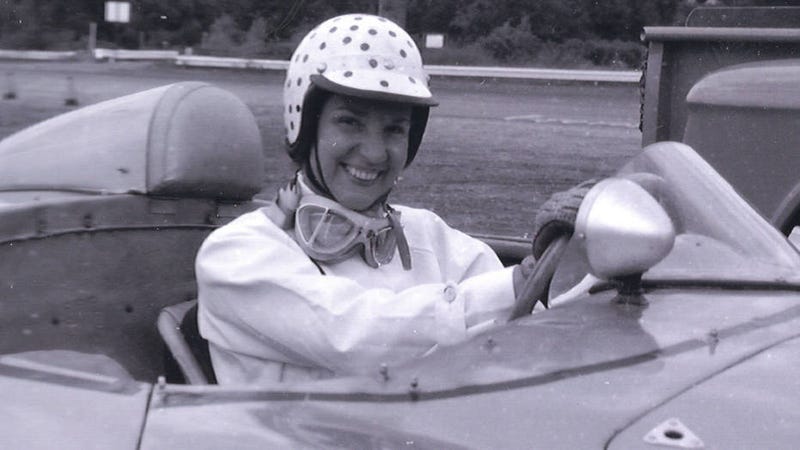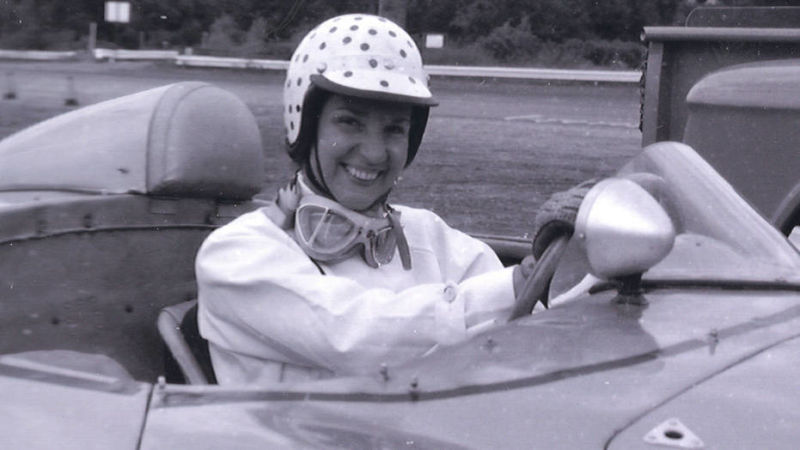
When Denise McCluggage was six years old, she spotted a beautiful Baby Austin 7 parked on the street of her hometown in El Dorado, Kansas. Infatuated by the small car’s beauty, she asked Santa Claus to bring her one for Christmas. Here was a woman destined for the wheel.
As per the New York Times, McCluggage got her first driver’s license at age 14 as the threat of World War II loomed large over the nation. With luxuries like car racing taking a backseat the production of wartime goods, McCluggage attended Mills College in Oakland, California studying philosophy and political economics and kicked off a career in photojournalism at the San Francisco Chronicle.
It was while covering a yacht race in the early 50s that McCluggage met Briggs Cunningham, the man responsible for building the first American cars to race at Le Mans. It revived that little spark inside her, the same one that inspired her to ask Santa for an Austin, and soon she was covering the post-war races around the country.
One particularly interesting effect of the war was its impact on racing. Grand Prix racing and sleek sports cars just weren’t America’s forte in the same way they were Europe’s. But some of the soldiers who came home from the war with a passion for adrenaline and speed came back with a love of European brands and the kind of racing you just couldn’t find in America. And the big European figures—like Juan Manuel Fangio, Stirling Moss, Jo Bonnier, and more—were crossing intercontinental borders to see what America had to offer.
It was an exciting time for the growth of motorsport, and McCluggage fell head over heels in love with the races she was covering. While still living in California, she bought an MG TC Midget, her very first sports car, and got behind the wheel herself. She started competing at local club events, small little things so different than the races she was seeing at tracks like Watkins Glen and Sebring. But it was the perfect place to begin honing her skills behind the wheel.
Advertisement
It was in California’s booming road racing scene that McCluggage started practicing a new form of writing: participatory sports journalism. She fully believed that she could cover races more effectively if she was an entrant instead of just a spectator; then, she could understand the racer’s mindset, feel out their lines on the track. And she would actually be allowed in the paddock—something that most female journalists were barred from at the time.
She got her big break in 1954 when she packed her bags and moved to the Big Apple to work for the New York Herald Tribune as a sports journalist. She left behind her MG and upgraded to a Jaguar XK140, a car better fit to start off a professional racing career.
McCluggage was the first woman to win a feature sportscar race at Thompson Raceway in Connecticut in 1959. Behind the wheel of a Porsche RS, she commanded the field and even went on to compete—and place a stunning fifth—in the United States Grand Prix at Watkins Glen the following year. McCluggage welcomed the 1960s by winning the GT Class at the 12 Hours of Sebring behind the wheel of a Ferrari.
Advertisement
Before long, she was being invited to races all over the word. She teamed up with the Ford factory team to drive a Falcon and win the prestigious 1964 Monte Carlo Rallye. You could find her name on the list of entrants at tracks like Daytona, the Nürburgring, and Elkhart Lake. She was doing it backed by big-name marques such as Porsche and Maserati. And she was competing against the likes of Stirling Moss, Phil Hill, and Carroll Shelby.
And, all the while, McCluggage was splitting her focus. She might be competing against some of the world’s best talents, but she was a journalist at heart. Her presence at the track meant that she was privy to the pre-race rituals, anxieties, fears, celebrations, and dramas that take place away from the public eye. She’d take track walks with Phil Hill as he daubed paint on the apexes he was worried he’d might miss. She chatted with Fangio and Moss on their dominant treks through Europe. She was, simply, just one of the guys.
What McCluggage was accomplishing was certainly no easy feat. As Autoweek recognizes, women had to fight tooth-and-nail to carve out a place for themselves in the racing world. Women weren’t always welcome to participate in the same big events as the men; instead, they’d be relegated to the “Ladies Races” that ran as support features for the main show. She was nominated to compete in Le Mans by Luigi Chinetti, only for the FIA to reject her presence because they “didn’t choose to invite women”. She would be forced to interview drivers through chain link fences at Indianapolis because women were strictly forbidden from the garage, pits, and press boxes.
Advertisement
It was a difficult life back then. So, McCluggage pulled on her helmet and won races. She found other ways to grab an interview: chatting to a driver in a hotel lobby, a quick side conversation at a dinner. She made sure her racing was impeccable and her stories were unlike anything anyone had ever heard before. Denise McCluggage’s name echoed through the racing world, refusing to be ignored.
McCluggage was one of the big factors behind the launch of AutoWeek, then called Competition Press. She started skiing because she was asked to write about it. And her list of acknowledgements and awards is incredibly long. She held the Ken W. Purdy Award for Excellence in Automotive Journalism and the Dean Batchelor Lifetime Achievement Award. She’s the only journalist to have been inducted in the Automotive Hall of Fame. She wrote a weekly syndicated column, “Drive, She Said”, which appeared in 90 newspapers throughout the US and Canada. And she still found time to write books.
McCluggage died in 2015 at the age of 88, but her legacy is still prevalent to this day. It is in part due to her tenacity that female journalists started being admitted to previously off-limit areas, that female drivers began to be more well-respected. She didn’t set out to change the scope of what being a woman in racing entailed, but she loved what she did and made damn well sure that she was going to get her access.
Advertisement
Her work is the kind that journalists can only hope to write. McCluggage crafted words with the care of a poet, so that reading a page felt a lot like unwrapping a Christmas gift. By Brooks Too Broad For Leaping, an anthology of some of her greatest works, reads less like sport journalism and more like the kind of novel you’d fall in love with in a literature class.
If you search McCluggage’s name, you’ll notice two things: her polka dot helmet and her wide smile. The memories captured in Kodachrome and nostalgia are incredible; McCluggage loved what she did. She was on a first name basis with the Golden Age titans of 1960s motorsport. She competed against them as equals and instilled in them a trust of her so that she would be sure to have the best story at the end of the weekend. In an era when women were often pushed off to the side, McCluggage stood against the status quo and made her name known.















